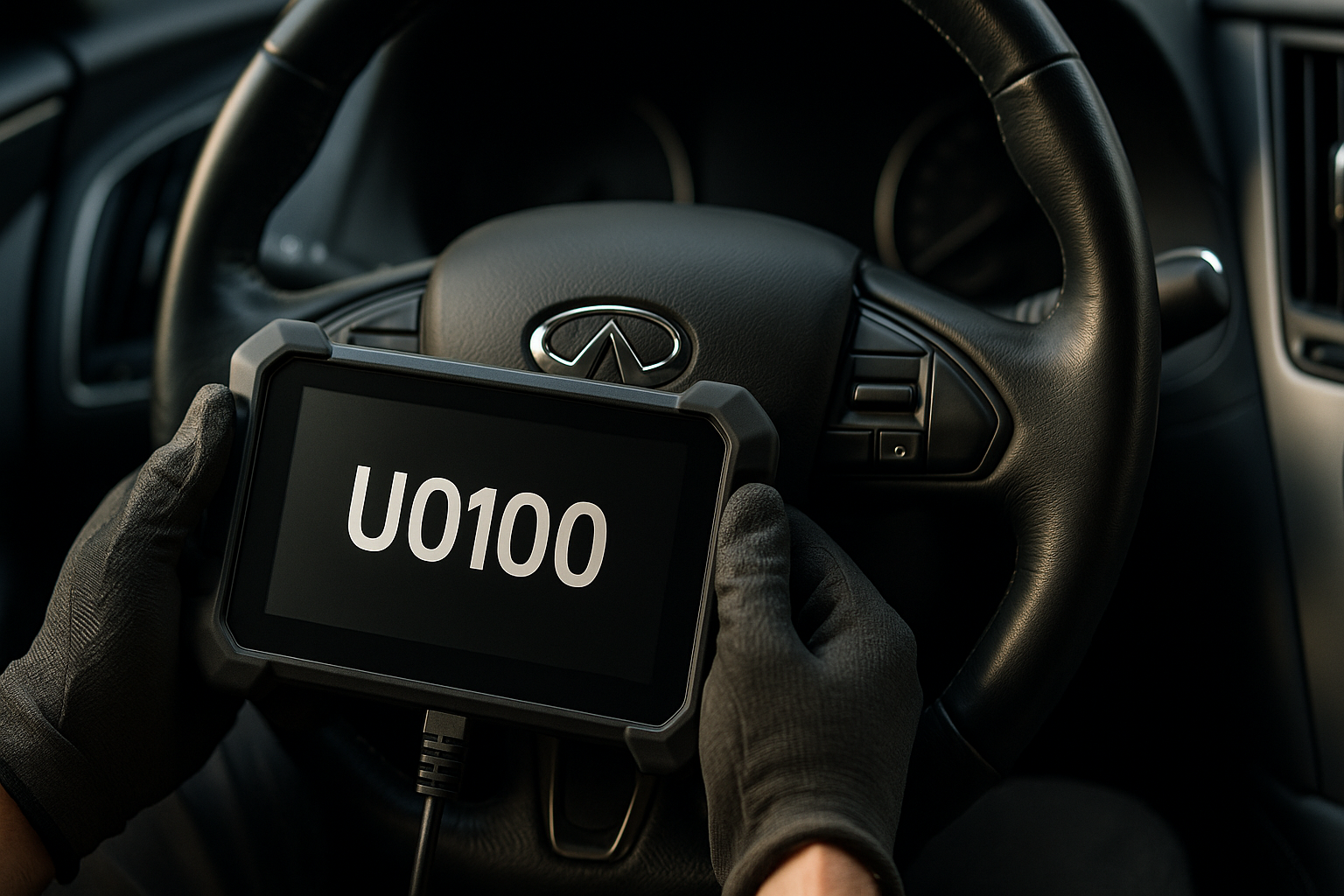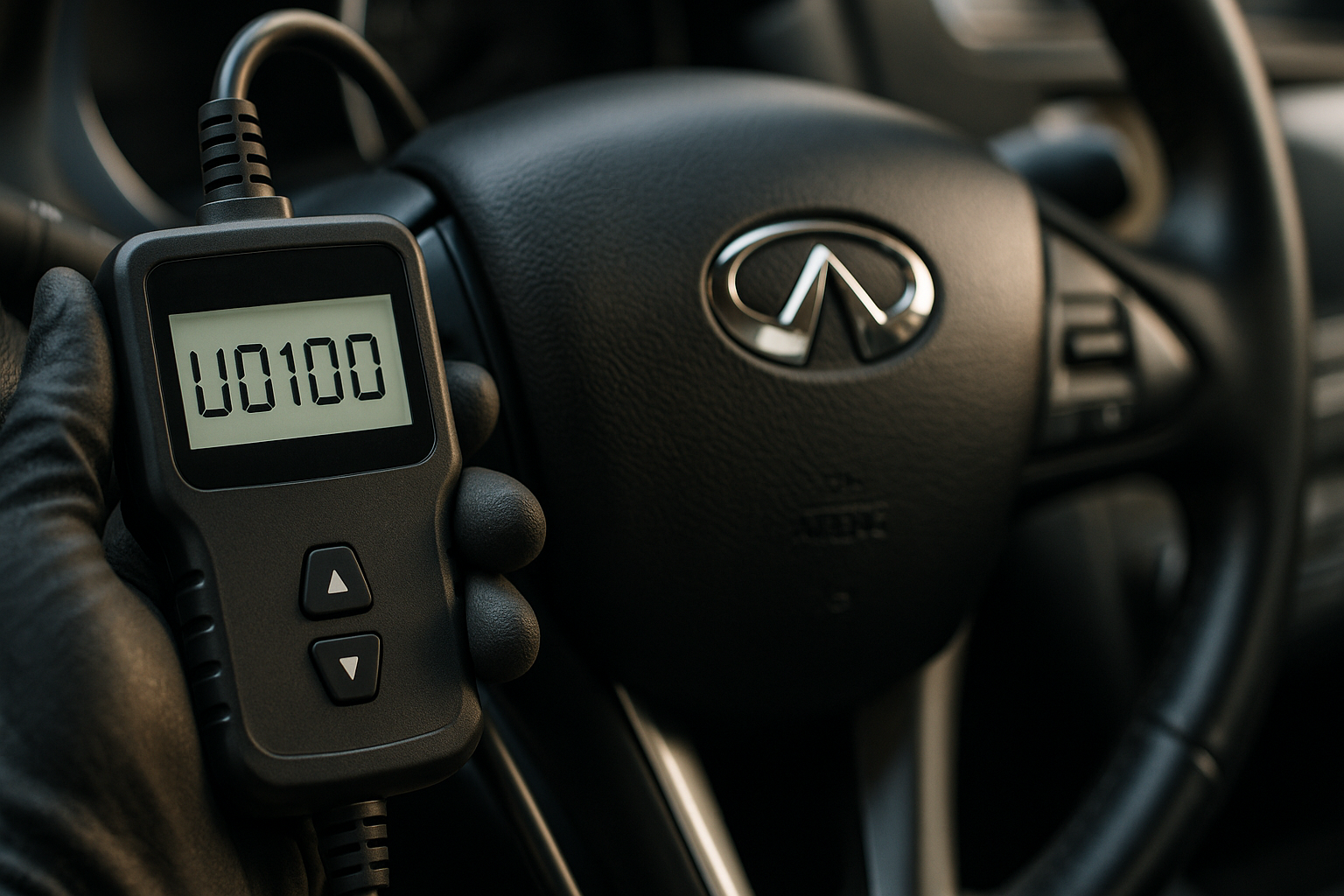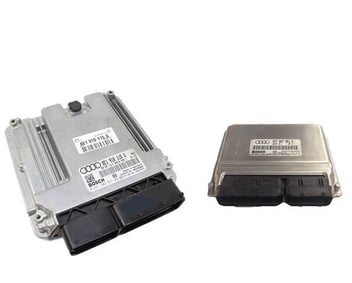How to Diagnose ECU/ECM “No Communication” (U0100) on Infiniti & Nissan
Last updated:


When your scanner says “No Comm” (and what that really means)
If your OBD-II tool can’t talk to the car and throws U0100, it’s telling you the vehicle’s network lost contact with the engine computer (ECU/ECM/PCM). On Infiniti and Nissan platforms, that can be as simple as low system voltage or a blown feed fuse—or as serious as a failed ECU or a CAN-bus wiring fault. Before you spend big on parts, use the step-by-step playbook below to confirm power/ground, check relevant fuses, isolate CAN issues, and decide whether your ECU needs professional repair. (Short version: U0100 = lost communication with the ECM/PCM, often caused by CAN wiring, power/ground, or the module itself. )
Start here: If you confirm the ECU is the root cause, repairing your original unit through UpFix preserves coding and typically costs far less than a new replacement. See Infiniti/Nissan ECU repair options.
What U0100 means on Infiniti/Nissan
-
Definition: U0100 = “Lost communication with ECM/PCM ‘A’.” It’s a network fault, not a single sensor code.
-
Why it happens: Low battery voltage, open/shorted CAN circuits, blown ignition feeds, bent pins, or a failed ECU can all drop the ECM off the network. Infiniti’s service flow charts specifically call out battery voltage, high-level fuses (e.g., “Ignition 1/2”), DLC power/ground, 60-ohm total CAN resistance, and normal CAN voltages.
Step-by-step diagnosis (mirroring the UpFix walkthrough)
Step 1 — Confirm the code and the symptom
-
Run a full auto-scan. If the tool won’t connect to “Engine,” that supports U0100/no-comm. Save any other network codes.
Step 2 — Rule out a weak battery first
-
Low voltage makes modules drop offline. A healthy 12-V battery is typically about 12.6 V with the engine off; charging voltage while running is ~13.5–14.5 V. Charge/replace if low before chasing wiring.
Step 3 — Check power feeds, grounds, and fuses
-
Verify ECM/PCM fuses/relays and the high-level ignition feeds that power multiple modules. Don’t skip the DLC (OBD socket) power and ground checks. Infiniti’s bulletin highlights that missing Ignition-2 or similar feeds can block CAN diagnostics.
Step 4 — Inspect connectors & harness
-
Reseat the ECM connectors; look for backed-out/bent/corroded pins. Trace CAN harness runs for chafe or oil-soaked insulation. (Infiniti notes pins can be bent and still pass a casual visual—look closely.)
-
Step 5 — Basic CAN health checks
With the vehicle asleep/key off, total bus resistance ≈ 60 Ω (two 120 Ω terminators in parallel). With key on, typical readings are ~2.7 V on CAN-H and ~2.3 V on CAN-L at the DLC when the network is awake. Readings far from these norms indicate opens/shorts.
Step 6 — Isolate the fault
-
If resistance isn’t 60 Ω, disconnect branches/modules per the OEM flow to find the leg causing the drop or short. Infiniti’s chart shows using 120 Ω substitutes to replace terminators during isolation.
Step 7 — Suspect the ECU only after feeds/grounds/CAN check out
-
If fuses/grounds are good, DLC power/ground is good, CAN health is normal, and the scanner still cannot communicate, the ECU itself may be the fault. That’s the point to consider a professional repair vs. replacement.
Can’t restore communication? Start an ECU repair order or submit a custom repair request.
Why repairing your original ECU is often the smartest move
If the network tests fine and the ECU still won’t talk, you’re likely dealing with an internal module fault. Replacing with a used or new ECU can work—but it may introduce coding and compatibility curveballs and higher costs. A repair-and-return service preserves your VIN-match and configuration while addressing the component-level failure directly. UpFix’s ECU/ECM program is built around that idea: send in your original, the team repairs and bench-tests it, then returns it ready to reinstall—often with posted turnaround guidance on the specific product page.
2017 Infiniti Q50 with intermittent U0100
A Q50 arrived with a dead-end scan—no “Engine” comms—but the rest of the network responded. The battery tested weak at rest; after replacement, most modules woke, yet the ECU still wouldn’t respond. CAN resistance and voltages at the DLC were normal, and fuses/relays fed the ECM correctly. With network health confirmed, the owner opted for repair-and-return. UpFix serviced the board, validated comms on the bench, and the ECU came back plug-and-play—no recoding drama. The first scan after reinstall connected immediately; the check-engine lamp stayed off on the post-repair drive
Owner tips that prevent repeat “no comm” headaches
Protect the basics that keep controllers online. Maintain battery health; voltage sags invite phantom network faults. Treat fuse/relay panels and ECU connectors gently—avoid aggressive pressure-washing near the bay. If you’ve had trim off for audio or dash work, make sure DLC feeds and grounds weren’t disturbed. And if you see sporadic U0100 after a collision repair or accessory install, revisit the routing of CAN harnesses—chafe and pin tension issues are classic intermittent offenders, a point Infiniti underlines in its network bulletin.
Why UpFix
UpFix has specialized in repair-and-return electronics since 2006, with programs covering ECUs/PCMs across Infiniti and Nissan lines. The advantage is straightforward: you keep your original coding, you avoid the roulette of used modules, and you follow a workflow that’s transparent—how to ship, how to track, what turnaround to expect—right on the website and help center. If your exact ECU isn’t listed, the Custom Repair Request route opens the door to parts that still can be serviced.
Read “How It Works & Shipping Instructions” before you pull the ECU (packing, labels, tracking).
2016 Nissan Altima with U0100 and random cluster warnings
This Altima produced U0100 and occasional dash warnings, plus long cranking. Initial suspicion fell on the ECU, but the stepwise approach paid off. The technician found corrosion at a fuse panel ignition feed and a slightly elevated resistance on the DLC ground. Cleaning and restoring those connections brought the network back online—no ECU repair required. The lesson mirrors the factory flow: feeds and grounds first, then CAN health, then modules.
FAQs
Does U0100 always mean the ECU is bad?
No. Many U0100 cases are caused by low battery voltage, missing ignition feeds, poor grounds, or CAN wiring faults. Confirm those before calling the ECU.
What numbers should I see on the CAN bus?
On many Infiniti/Nissan platforms, expect ~60 Ω total resistance key-off and, key-on, about 2.7 V on CAN-H and 2.3 V on CAN-L at the DLC when the network is awake. Outliers suggest opens/shorts that must be fixed.
Why repair my original ECU instead of buying used?
Repair retains your coding and configuration and addresses the failure at board level. Used units can inherit unknown issues and still require programming. UpFix’s service is built around keeping your original module intact.
How do I ship the ECU and track everything?
Use UpFix’s packing and shipping guidance, and track status from your order page or with your own label’s tracking number.
Fix the communication problem once then keep it fixed
The fastest way out of a U0100 hole is discipline, not guesswork. Stabilize the battery, verify the fuses/relays and DLC feeds, reseat every connector with a hard look for bent or backed-out pins, then read the CAN bus like a health chart: 60 Ω total, and the familiar split voltages when it’s awake. Infiniti’s diagnostic flow is explicit because it saves time and money—replace nothing until the network proves it needs replacing. If, after all of that, the ECU still won’t talk, repairing your original module is the cleanest path: no coding roulette, no matching-part-number scavenger hunt, and a bench-tested unit that’s ready to plug right back in. UpFix exists for that exact moment, with clear service pages, shipping instructions, and a repair-and-return workflow that’s been refined by years of solving “no comm” cases across Infiniti and Nissan. Start smart, follow the map, and you’ll finish with a scan tool that connects on the first try—and a car that behaves the way it should.

 upfix.com
upfix.com 888-979-9343
888-979-9343


